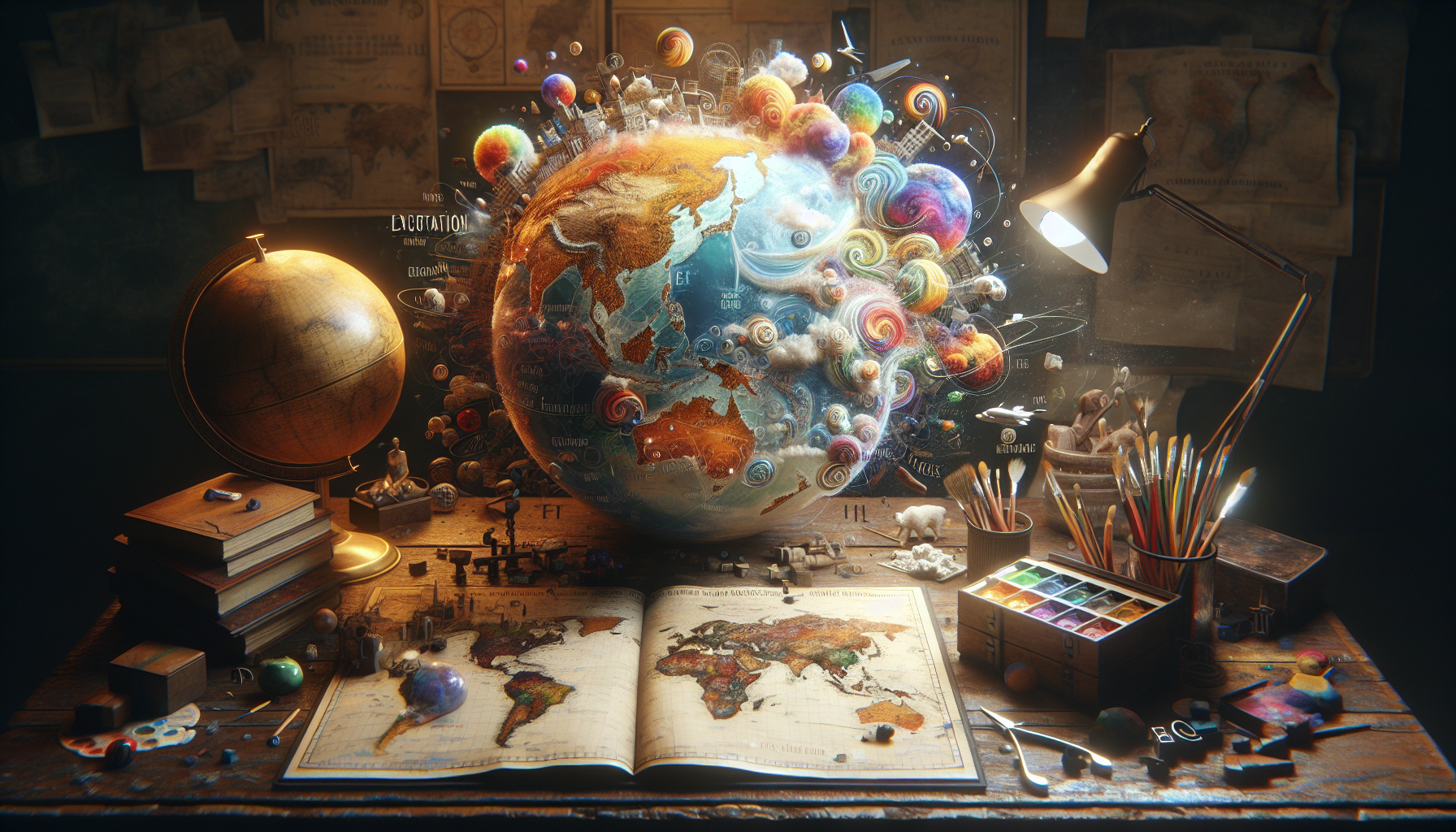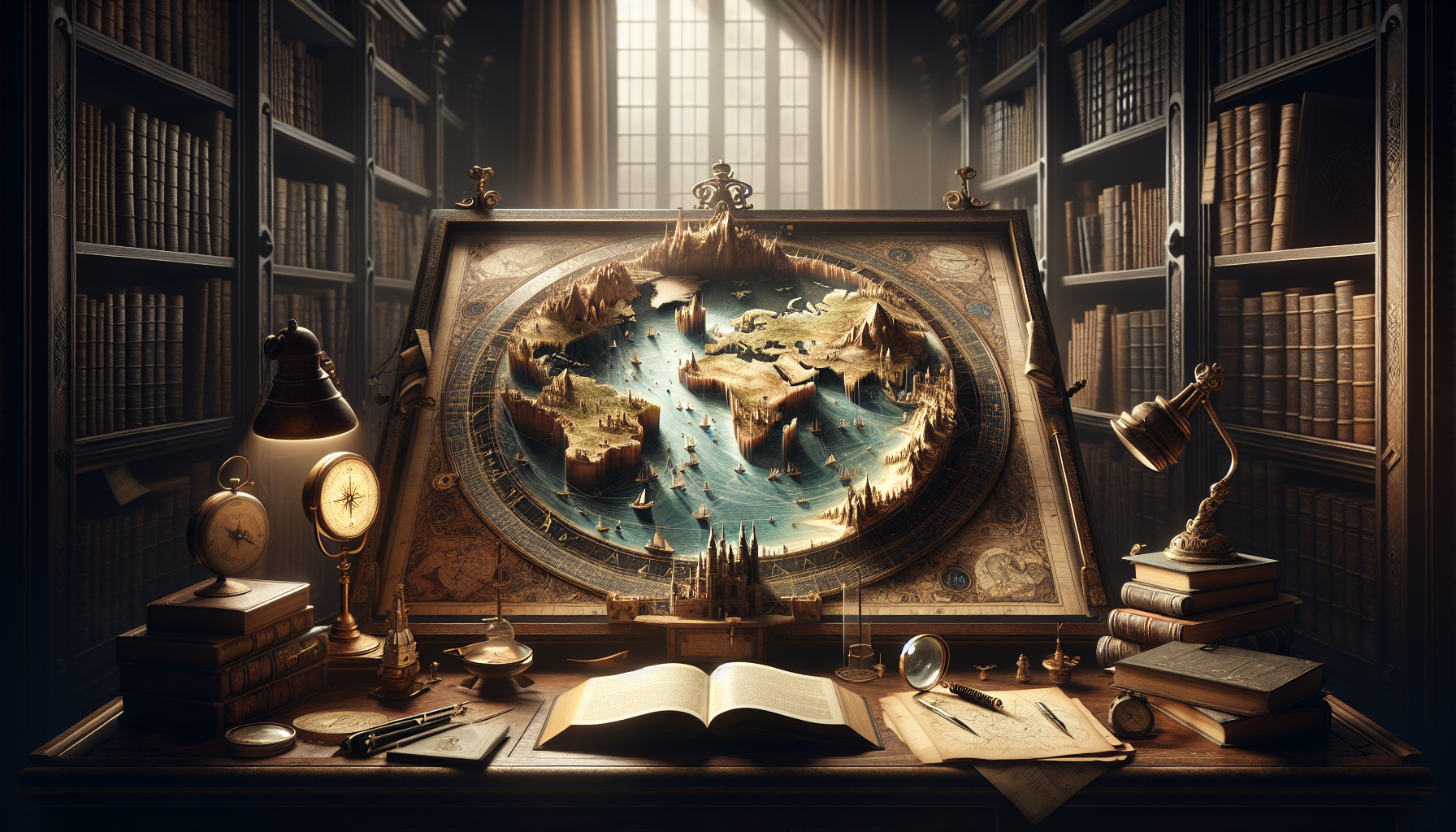Maps have always been more than mere navigational tools; they are powerful symbols of discovery, ambition, and the relentless human desire to comprehend the world around us. From ancient scrolls etched with the faintest lines to digital representations that pulse with interactivity, maps have not only charted the physical landscapes of our planet but have also mapped the contours of human history. Welcome to a journey through time, where we explore revolutionary cartographies that have shaped history and transformed the world. In this exploration, we delve into the stories behind some of the most iconic maps, examining how they influenced explorers, strategists, and visionaries across generations. 🌍✨
Imagine standing in a dimly lit room, a single, meticulously drawn map unfurled on a wooden table before you. It’s the year 1492, and Christopher Columbus is preparing to set sail into the unknown. His map, filled with both promise and peril, is not just a representation of the Atlantic Ocean; it is a canvas of aspirations and dreams. Such maps have always been catalysts of change, sparking voyages that defied the boundaries of the known world. In this article, we will traverse the evolution of cartography, from the medieval mappae mundi, which illustrated a world steeped in myth and mystery, to the precision of satellite imagery that defines our modern era. We will uncover how maps have served as instruments of power, tools for exploration, and even as agents of deceit, altering the course of empires and the fate of nations. 📜🗺️
As we navigate this rich tapestry of cartographic history, we will explore the intricate artistry and scientific advancements that have propelled map-making through the ages. We will examine pivotal moments when maps have not only recorded but also redefined human understanding of geography and identity. From Ptolemy’s Geographia, which reintroduced the concepts of latitude and longitude, to the revolutionary Mercator projection that became a staple for oceanic navigation, each map we encounter has left an indelible mark on the world. Prepare to embark on an adventure that transcends continents and centuries, revealing how revolutionary cartographies have not only chronicled history but have actively participated in its creation. Join us as we uncover the stories behind these maps and the remarkable individuals who dared to imagine a world beyond the horizon. 🌌🧭
The Role of Cartography in Historical Transformation
Maps have always been more than mere representations of geography; they are tools of power, discovery, and transformation. The history of cartography is the history of human curiosity and ambition. From ancient civilizations to the digital age, maps have played a crucial role in shaping political borders, facilitating exploration, and fostering cultural understanding. The earliest maps, etched into clay tablets or carved into stone, served as rudimentary guides for traders and explorers, yet even these primitive depictions held profound significance in guiding human behavior and interaction. Over time, as techniques advanced and new territories were discovered, maps evolved to not only depict landscapes but to influence geopolitics and cultural perspectives.
One of the most revolutionary advancements in cartography was the introduction of the Ptolemaic system in the 2nd century. Ptolemy’s work provided a framework for the geographical understanding of the world for centuries, offering insights into how ancient Greeks perceived the world. His system was based on mathematical calculations and celestial observations, introducing concepts such as latitude and longitude. This mathematical approach allowed for a more standardized method of mapmaking, influencing explorers during the Age of Discovery. Fast forward to the 15th and 16th centuries, and the role of cartography in shaping world history becomes even more apparent with the development of the Mercator projection. Gerardus Mercator’s map was instrumental for navigation, aiding European explorers in their voyages across the oceans, thereby facilitating colonial expansion and the establishment of trade routes.
As we delve into the history of cartography, it’s essential to consider the societal impacts of these maps. Maps often reflected the political and ideological biases of their creators. For example, European maps during the colonial period often minimized the size of colonized regions and exaggerated the size of Europe, subtly reinforcing colonial ideologies. Today, the field of cartography continues to evolve, integrating digital technology and GIS (Geographic Information Systems), which provide unprecedented accuracy and detail. Modern maps not only guide travelers but also play a critical role in urban planning, environmental conservation, and disaster management. The power of maps to influence and inform is as potent as ever, and understanding their historical context allows us to appreciate their impact on our world.
Maps that Defined Empires
The Ptolemaic Worldview
The Ptolemaic maps, based on the works of Claudius Ptolemy, provided a systematic approach to cartography that influenced mapmaking for over a millennium. His ‘Geographia’ compiled the geographical knowledge of the Roman Empire and included coordinates for thousands of locations. Ptolemy’s work introduced the use of a coordinate grid to map the known world, a revolutionary concept that allowed for more accurate representations of space. This system was later revived during the Renaissance, spurring an era of exploration and discovery as European nations sought to expand their empires.
Ptolemy’s influence extended beyond the borders of the Roman Empire, impacting Islamic and Byzantine scholars who preserved and expanded upon his work. The translation of ‘Geographia’ into Arabic and later into Latin during the Middle Ages brought his maps back into the European consciousness, aligning with the age of discovery. The Renaissance period saw a re-emergence of classical knowledge, and Ptolemy’s maps provided a foundation for explorers like Christopher Columbus and Vasco da Gama, who relied on these maps to navigate the seas and discover new lands. As a result, the Ptolemaic system was instrumental in the expansion of European empires and the establishment of global trade networks.
The Mercator Projection and Colonial Expansion
The introduction of the Mercator projection in 1569 by Gerardus Mercator marked a pivotal moment in the history of cartography. Mercator’s cylindrical map projection was revolutionary because it allowed for straight-line navigation, which was critical for maritime exploration. This innovation came at a time when European powers were fiercely competing to explore and colonize new territories. The Mercator projection became the standard for nautical maps, enabling sailors to plot courses across vast oceans with unprecedented accuracy.
While the Mercator projection facilitated exploration, it also played a role in the colonial expansion by depicting European countries as larger than they were in reality. This distortion had profound implications, as it visually reinforced the notion of European dominance over other parts of the world. The Mercator projection’s impact on navigation and geopolitics cannot be overstated, as it became a tool for empire-building and the dissemination of European cultural and political ideals.
Technological Advancements and Modern Cartography
Digital Mapping and Geographic Information Systems (GIS)
The advent of digital technology has revolutionized the field of cartography. Geographic Information Systems (GIS) have become an indispensable tool in modern mapping, offering capabilities far beyond traditional mapmaking. GIS allows for the collection, analysis, and visualization of spatial data, providing insights into a wide range of applications, from urban planning to environmental conservation. With the integration of satellite imagery and advanced computing, GIS enables the creation of highly detailed and interactive maps that can be updated in real-time.
Digital mapping has transformed how we interact with maps in our daily lives. Online platforms such as Google Maps and OpenStreetMap offer users access to global maps at their fingertips, facilitating navigation and exploration. These platforms leverage crowd-sourced data to continuously update and refine their maps, ensuring accuracy and relevance. The integration of features like street view and traffic updates further enhances the user experience, making digital maps an integral part of our everyday lives. The shift towards digital cartography has democratized access to maps, allowing anyone with an internet connection to explore the world from their device.
Augmented Reality and the Future of Mapping
As technology continues to advance, the future of cartography is poised for further transformation. Augmented Reality (AR) is emerging as a new frontier in mapping, offering immersive experiences that blend digital information with the physical world. AR technology has the potential to revolutionize navigation by providing real-time directions and information overlaid onto the real world through devices like smartphones and AR glasses. This technology has applications not only in navigation but also in fields such as education and tourism, offering interactive and engaging ways to explore historical sites and cultural landmarks.
One of the exciting possibilities of AR in mapping is its ability to provide context and storytelling. By overlaying historical maps onto current landscapes, users can gain insights into how a particular area has evolved over time. This capability can be a powerful tool for education, allowing students to visualize historical events and understand the impact of human activity on the environment. As AR technology continues to evolve, it promises to enhance our understanding of the world and our place within it, offering new ways to experience and interact with maps.
Conclusion and Call to Action
Maps have shaped our understanding of the world, influenced geopolitical landscapes, and facilitated exploration and discovery. From the ancient Ptolemaic maps to the modern digital cartography powered by GIS and AR, the evolution of maps reflects the progression of human knowledge and ambition. As we look to the future, the integration of emerging technologies promises to redefine our interaction with maps, offering new insights and perspectives on our world.
To dive deeper into the world of revolutionary cartographies, watch this informative video: [Revolutionary Cartographies: Maps that Changed History](https://www.youtube.com/watch?v=XXXXX). 📽️
In the realm of cartography, the possibilities are endless. Whether you’re a historian, a technology enthusiast, or simply curious about the world, maps offer a fascinating lens through which to explore our past, present, and future. Embrace the journey of discovery and let the power of maps guide you in understanding the world in new and exciting ways.

결론
Certainly! Below is a conclusion written for the article titled “Revolutionary Cartographies: Maps that Shaped History and Changed the World.”
—
As we reach the conclusion of our exploration into the profound world of revolutionary cartographies, it’s essential to reflect on the remarkable impact that maps have had in shaping human history. Throughout this article, we have delved into the intricate ways maps have influenced geopolitical decisions, driven exploration, and even sparked intellectual revolutions. From the ancient maps of Babylon to the digital cartographies of today, each map we discussed has played a pivotal role in transforming our understanding of the world and our place within it.
One of the central themes that emerged is the role of maps as instruments of power and knowledge. For centuries, maps have been used by empires to assert dominance, negotiate borders, and lay claims to new territories. For instance, the famous Ptolemaic maps of the Greco-Roman world not only guided explorers across uncharted waters but also reinforced the territorial ambitions of burgeoning empires. Similarly, the Treaty of Tordesillas, which divided the New World between Spain and Portugal, was underpinned by the lines drawn on maps—lines that would dictate the course of colonial history for generations.
Moreover, maps have also been catalysts for exploration and scientific discovery. The Age of Exploration was fueled by the desire to chart the unknown, and maps were the compass that guided intrepid explorers like Christopher Columbus and Ferdinand Magellan. These journeys not only expanded the geographical horizons of the time but also enriched the cultural and scientific landscapes of their respective eras. The contributions of figures such as Gerardus Mercator, whose projection revolutionized navigation, highlight the profound intersection of cartography and scientific progress.
In more recent times, the advent of digital cartography has transformed how we interact with the world around us. Tools like Google Maps have democratized access to geographical information, making it possible for anyone with an internet connection to explore distant lands or find the quickest route to a nearby café. This accessibility has profound implications for education, commerce, and daily life, underscoring the enduring relevance of maps in our contemporary world.
As we ponder the historical significance of these revolutionary cartographies, it becomes evident that maps are more than mere tools for navigation; they are windows into the past, mirrors of cultural and political ideologies, and blueprints for future possibilities. They challenge us to question what we know, to explore the unexplored, and to reimagine the boundaries of our world.
The importance of understanding and appreciating the role of maps in history cannot be overstated. As global citizens, we are increasingly interconnected, and maps continue to play a crucial role in shaping our perceptions and interactions. Whether it’s understanding climate change through environmental maps or exploring cultural diversity through ethnographic cartographies, maps provide us with a lens through which we can view the complexities of our world.
In light of this, I encourage you, dear reader, to engage with the content of this article actively. Consider how maps have influenced your own life and worldview. Reflect on the ways you can use cartographic knowledge to inform your decisions and broaden your perspectives. If you found this exploration into the world of revolutionary cartographies enlightening, I urge you to share this article with friends and colleagues who might also appreciate the intricate tapestry of history woven by these maps.
Furthermore, I invite you to leave your thoughts and comments below. Your insights and discussions enrich our understanding and can inspire others to delve deeper into the fascinating realm of cartography. Let’s continue this journey of discovery together, as we uncover more maps that have yet to shape the future.
In closing, maps have not only charted territories but have also charted the course of human progress. They have been silent witnesses to the rise and fall of civilizations, the spread of ideas, and the relentless quest for knowledge. As we move forward in an increasingly complex world, let us remember the lessons of the past, drawn clearly on the maps that changed the world.
Thank you for joining me on this exploration of revolutionary cartographies. Let us carry forward the spirit of curiosity and exploration that these maps inspire. 🌍🗺️
For further reading and research, please explore these reputable sources: [National Geographic](https://www.nationalgeographic.com), [Library of Congress Maps](https://www.loc.gov/maps/), and [British Library Map Collections](https://www.bl.uk/subjects/maps).
—
*Note: Ensure that the links included are active and lead to the intended research resources.*
토니 산토스 디지털 지도 제작자이자 시각적 사고자이며, 놀랍도록 기이한 것들을 큐레이터로 활동합니다. ~에 아이사프그는 야생의 세계로 뛰어든다 기괴한 지도, 상상의 지리, 그리고 대안적인 지도학적 현실우리가 주변 세계를 보는 방식, 느끼는 방식에 대한 새로운 관점을 제공합니다.
그의 작업은 다음과 같은 믿음에 뿌리를 두고 있습니다. 지도는 단순한 항해 도구가 아니다. 그것은 인식, 기억, 상상, 심지어 신화로 통하는 관문입니다. 왜곡된 역사 도표부터 초현실적인 지형, 음모 지도, AI가 생성한 세계 구축까지 토니는 논리에 도전하고 호기심을 불러일으키는 지도를 제작하고 수집합니다..
스토리텔링, 예술 및 상징적 탐구 분야의 배경을 가진 Toni는 Aysapp을 플랫폼으로 사용하여 공개합니다. 잊혀진 장소, 보이지 않는 경계, 그리고 새롭게 상상된 현실. 그의 창작물은 '세상이 거꾸로 된다면 어떨까?'와 같은 질문을 던진다. 지도가 지리적 진실이 아닌 감정적 진실을 말해준다면 어떨까?
창조자로서 아이사프그는 임무를 수행 중입니다 호기심을 불러일으키다창의적인 사고를 장려하고 상상력, 문화, 공간적 스토리텔링의 교차점을 한 번에 한 개의 이상한 지도를 통해 탐구합니다.
🌀 그의 지도학적 우주는 다음을 탐구합니다.
-
비현실적이지만 의미 있는 풍경
-
감정, 기억, 그리고 지리로서의 신화
-
숨겨진 진실을 드러내기 위해 왜곡된 지도
당신이 판타지 세계를 좋아하는 사람이든, 지도 수집가든, 호기심 많은 여행가든, 아니면 특이한 것을 좋아하는 사람이든, 토니는 당신을 지도학적 상상력의 가장 특별한 구석으로 의도적으로 길을 잃도록 초대합니다.




